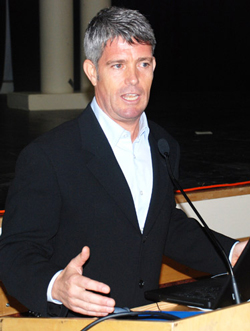 |

In our rapidly changing and technologically complex society, schools are being asked to educate the most diverse student body in history to higher and higher academic standards. Some students—disproportionately boys—are bored, disconnected, and underachieving. Parents worry when they see their boys arrive home from school with negative attitudes toward classroom learning. They grieve when they see the spark of enthusiasm for learning flicker and die.
Many people have assumed that teaching and learning are gender-neutral and free of bias, but we have recently become uncomfortably aware of ways in which differences in the cultures of masculinity and femininity influence attitudes toward teaching and learning. Within the stability of the school structure gender biases are expressed in the power structure – in the ways that people work together and treat each other – all of which send important messages about gender expectations to both boys and girls. The versions of masculinity and femininity which are inculcated in classrooms become part of students’ social identities.
Experts who are not simply smitten by arguments about test score differentials and gender achievement gap have identified differences between boys and girls that go far beyond obvious biological differences.
Understanding the varying needs of boys is crucial for their school success.
Boys do not need excuses for bad
behaviour, nor do they need rescue from their masculinity. They need respect, discipline, guidance, and understanding.
How can we help boys to be more themselves without pitting their needs against the needs of girls, without ignoring those who are economically or intellectually disadvantaged or who are marginalized in other ways?
How can we instill in our boys a sense of community and global citizenship, healthy intellectual skepticism, respect for others, and appreciation for our abundant diversity?
As we consider the particular responses of schools to the varied educational needs of boys in their communities, we cannot forget the central mandate of public education: promoting critical inquiry within an inclusive and supportive community.
To arrange for a Boy Smarts educator event please contact info@mentoringboys.com

Barry MacDonald and Serge-Edouard Jeanniton (principal of McCaig Elementary in Rosemere, Quebec) smile for the camera after their skit about boys who present as angry but are mostly anxious.

|

“We must help boys to use their time, energy, and talents in positive and contributory ways – it’s that simple. Boy Smarts and its accompanying Boy Smarts Action Study Guide provide perceptive and thoughtful points of inquiry for learning communities to accomplish this goal with boys of all ages and from all walks of life. It lays the foundation for constructive and positive futures.”
– Marilyn McGuire, Seattle
International Consultant, Former Principal, Author, Gangs and Violence: School-wide Strategies for Prevention and Intervention

To arrange for a Boy Smarts educator event please contact info@mentoringboys.com
|
 |
|
|

 |
Teacher appreciates balanced approach...
As a parent and teacher I found your engaging presentation to be a real eye opener. I loved it!
I grew up in a home with my mom, my sisters and myself, and I certainly wish I had been to your talk and read Boy Smarts as a beginning teacher!
I found myself struggling with boys who fidgeted, were constantly moving, and had difficulty paying attention at circle time.
It wasn¹t until your talk last week that I really understood how spatial some boy¹s brains are and some girls for that matter.
I personally don't like visual puzzles and still have difficulty figuring out who got to the 4-way stop intersection first. I have been astonished by how little verbal instructions some boys need. I now understand why some boys and girls got lost in my lengthy instructions.
Although I learned a lot in those early years of teaching, I still wasn't completely prepared to become a parent of three loud and rambunctious boys, with the two youngest as twins! Our family life has certainly had its moments.
While I am grateful that many boys have "spider senses" and are comfortable with eye contact, my boys, and I'd guess about half of the boys I teach, seem not to.
Your comments about how managing anxiety varies with each person encouraged me to be more observant of my own eye contact.
I found your comments about the gender gap particularly useful as a teacher.
While you smartly didn't support the popular notion that all boys are underachieving or suggest a one size fits all to remedy a situation that clearly does not exist, you asked questions that really got me thinking.
You helped me to understand that genders don¹t come from Venus and Mars and yet there are tendencies to be aware of.
Some of the books I¹ve read claim that boys and girls learn differently or that they are victims of our macho culture and need rescuing. Your notion of the gender continuum (you also referred to it as a gender matrix) side-stepped stereotypes and conceptualized gender in such a practical way for me.
Your broad spectrum view opens up this politically hot topic in a way that brings sensitivity and appreciation for our rich diversity as humans.
I am looking forward to participating in an after school discussion group with colleagues using your latest book, Boy Smarts Action Study Guide to consider the 100 guidelines outlined in Boy Smarts.
Thank you for being a champion for boys while also respecting girls' needs and advocating for all kids. You have reminded me why I love teaching!
Monique,
Toronto




|
|








